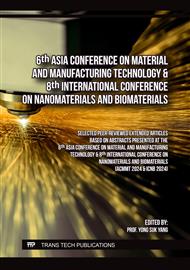p.3
p.11
p.17
p.25
p.33
p.41
p.51
p.61
Immobilization of Silver Nanoparticles on Silica Particles by Silver Mirror Reaction
Abstract:
This paper presents the synthesis of metallic silver (Ag) nanoparticles immobilized on silica (SiO2) particles. Ag immobilization was carried out via the Ag mirror reaction using two types of reducing reagents: D-glucose and formaldehyde (HCHO). The effects of Ag immobilization conditions, such as Ag nitrate concentration, SiO2 concentration, reaction time, and reducing reagent concentration, were investigated. The particle morphology is related to the ionic strength of the solution. As a result, Ag immobilization was successfully performed while minimizing the formation of large metallic Ag nanoparticles and/or the aggregation of metallic Ag nanoparticles in the HCHO system with a reaction time of 5 min and HCHO concentration of 1.5×10-4 M, producing SiO2 particles (92.5±7.3 nm) immobilized with metallic Ag nanoparticles 5–15 nm in size.
Info:
Periodical:
Pages:
3-9
Citation:
Online since:
March 2025
Authors:
Keywords:
Price:
Сopyright:
© 2025 Trans Tech Publications Ltd. All Rights Reserved
Share:
Citation:



